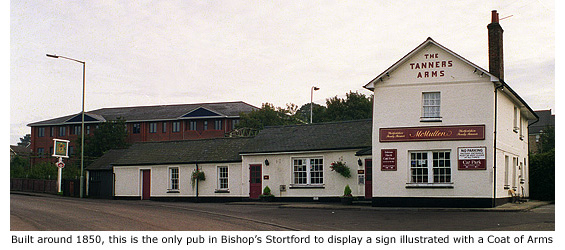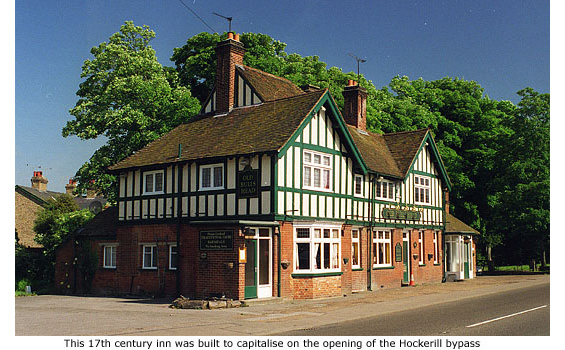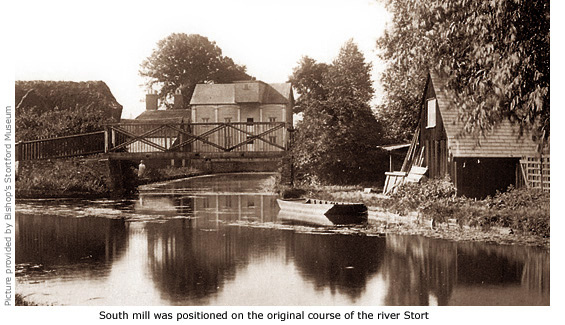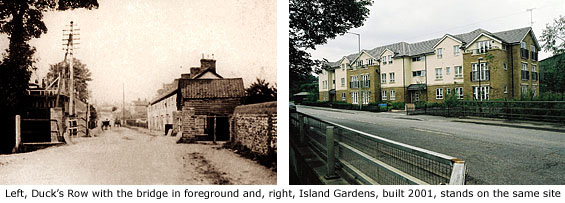|

 Built around 1850 alongside a former tannery, the Tanners Arms public house was first owned by Joseph Whitby and acquired by McMullens Brewery of Hertford in 1895. Former stables to the left of the building now form part of the pub’s interior, and its sign is the only one in Bishop's Stortford to depict a trade coat of arms. Built around 1850 alongside a former tannery, the Tanners Arms public house was first owned by Joseph Whitby and acquired by McMullens Brewery of Hertford in 1895. Former stables to the left of the building now form part of the pub’s interior, and its sign is the only one in Bishop's Stortford to depict a trade coat of arms.
Land to the right of the pub, currently (2006) being redeveloped to house offices and 5 apartment blocks comprising 130 homes, was previously the site and UK head office (1968 – 2003) of timber merchant S. J. Atkins & Cripps Ltd. Established in 1852 and now owned by Timbmet Silverman – the UK's leading importer and distributer of hardwoods – the timber yard replaced a large malting once serviced by its own railway siding running behind the Tanners Arms.
Atkins & Cripps were prompted to sell their site for redevelopment when local regulations made it difficult for large trucks to deliver wood. The business has now moved to Ely, Cambridgeshire.
County Bridge, also known as Red Bridge, takes London Road over the Stort Navigation. On the river-side of the bridge an inscription proclaims it was rebuilt and strengthened in 1913, but what it doesn’t tell you is that it is named County Bridge because the river at this point forms the county line between Essex and Hertfordshire.
A narrow pathway longside the bridge on the west side of the road, leads to the former towpath where the river's course splits into two waterways. To the left is the Navigation route and to the right the river's original course that led to the watermill known as South Mill. In the early 19th century Marshall’s barge building yard was situated on the opposite bank.
|
|
Some 50 metres south of County Bridge, in London Road, another opening leads through a small woodland area to where South Mill once stood.
Water wheels were known to the Greeks during the 1st century BC and are thought to have been introduced to this country by the Romans for grinding corn. But it was the Saxons who developed their use in the 8th century, and at the time of Domesday Book (1086), South Mill and the Town Mill were just two of 5,264 recorded mills in operation throughout the land.
|
|

 Built in the late 17th century after the opening of the Hockerill bypass, this former coaching inn once boasted a fine open fireplace, part of a wall painting and seven bedrooms in which to accommodate travellers. Recorded as The Bull in 1735 it was altered in the 18th and 19th centuries and extensively modernised in the late 1960s. But Stortford's dwindling pub trade has no room for sentiment and in early 2007 it closed its doors for the last time, reopening shortly after as a Thai restaurant named Baan Thitiya. Built in the late 17th century after the opening of the Hockerill bypass, this former coaching inn once boasted a fine open fireplace, part of a wall painting and seven bedrooms in which to accommodate travellers. Recorded as The Bull in 1735 it was altered in the 18th and 19th centuries and extensively modernised in the late 1960s. But Stortford's dwindling pub trade has no room for sentiment and in early 2007 it closed its doors for the last time, reopening shortly after as a Thai restaurant named Baan Thitiya.
At the rear of the property runs the original course of the river Stort, now just a small tributary that continues under London Road bridge then once again joins the Navigation course.
Opposite the former inn is the aptly named Island Court, a residential development constructed in 2001. The name is derived from the fact that this small area of land is surrounded by two river courses – the old river Stort and the Stort Navigation – and residents here can rightly lay claim to being the only people in Bishop’s Stortford who actually live on an island.
Island Court is built on the former site of a second-hand car business which, prior to that, was the site of the Acme cafe - a transport cafe catering for the many lorry drivers and travellers that used this main route between London and East Anglia from the 1930s until the cafe's demise around the 1960s.
For much, if not all, of that time the Acme cafe was owned and run by Charles Judd, a man whose criminal activities during the Second World War were well known to the local police and the courts.
Long before this, though, there stood here a small terrace of 19th century cottages named Duck's Row, seemingly built in an idyllic spot alongside the river. It was indeed an enviable place to live in fine weather but when the River Stort was in spate, as it often was, the name ‘Duck's Row’ took on a completely different meaning. Floodwaters would regularly enter the cottages by their back doors and, quite literally, leave by the front.
The cottages were also known locally as ‘bug hutches’, one former resident terming the regular lime washing of their exteriors as bug binding. Landlord Joe Brazier (See Guide 6) rented each home at one shilling and sixpence (7 1/2p) per week, but after enduring years of constant flooding the residents were eventually re-housed and the terrace demolished in the 1930s.
|






 Built around 1850 alongside a former tannery, the Tanners Arms public house was first owned by Joseph Whitby and acquired by McMullens Brewery of Hertford in 1895. Former stables to the left of the building now form part of the pub’s interior, and its sign is the only one in Bishop's Stortford to depict a trade coat of arms.
Built around 1850 alongside a former tannery, the Tanners Arms public house was first owned by Joseph Whitby and acquired by McMullens Brewery of Hertford in 1895. Former stables to the left of the building now form part of the pub’s interior, and its sign is the only one in Bishop's Stortford to depict a trade coat of arms.
 Built in the late 17th century after the opening of the Hockerill bypass, this former coaching inn once boasted a fine open fireplace, part of a wall painting and seven bedrooms in which to accommodate travellers. Recorded as The Bull in 1735 it was altered in the 18th and 19th centuries and extensively modernised in the late 1960s. But Stortford's dwindling pub trade has no room for sentiment and in early 2007 it closed its doors for the last time, reopening shortly after as a Thai restaurant named Baan Thitiya.
Built in the late 17th century after the opening of the Hockerill bypass, this former coaching inn once boasted a fine open fireplace, part of a wall painting and seven bedrooms in which to accommodate travellers. Recorded as The Bull in 1735 it was altered in the 18th and 19th centuries and extensively modernised in the late 1960s. But Stortford's dwindling pub trade has no room for sentiment and in early 2007 it closed its doors for the last time, reopening shortly after as a Thai restaurant named Baan Thitiya.